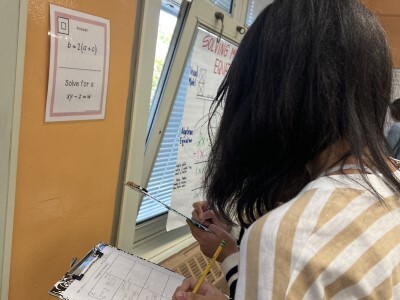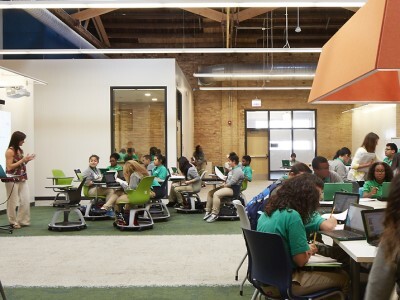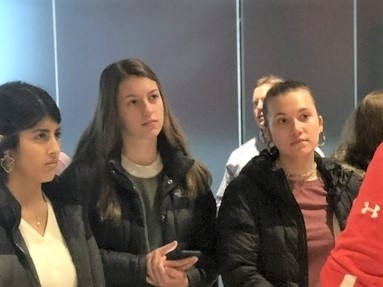Taking a Risk with Authentic Learning at Boston International Newcomers Academy
Topics

We’ve all had the experience of truly purposeful, authentic learning and know how valuable it is. Educators are taking the best of what we know about learning, student support, effective instruction, and interpersonal skill-building to completely reimagine schools so that students experience that kind of purposeful learning all day, every day.
Boston International Newcomers Academy (BINcA) is trailblazing new learning environments in Boston Public Schools.
There is great interest in redesigning classrooms for next gen learning but it’s often difficult to know how to proceed. Boston International Newcomers Academy (BINcA), a high school that embraces recent immigrant English language learners and their families, is trailblazing new learning environments in Boston Public Schools (BPS). This is the story of one 11th grade classroom at BINcA in school year 2017-18.
Problem-Finding
(See 8 Characteristics of the "Innovator's Mindset".)
In 2017 several BINcA rising juniors, including Carolyn de Jesus Martinez, originally from the Dominican Republic, and Deina da Costa Lopes of Cabo Verde, were participating in a Girls Who Code Summer Immersion Program at TripAdvisor through the support of Andrew Flye, BINcA’s Physics/Exploring Computer Science teacher. The young women, both of whom had arrived in Boston from their homelands two years earlier, were fascinated by the design of TripAdvisor’s work environment—an open office plan with flexible working and meeting spaces, adjustable tables, and a huge number of whiteboards where groups could brainstorm and collaborate. According to Deina:
“Everyday we would start by listening to the teacher explaining how a computer language works, such as Python, HTML, and show us examples and tell us to try on our own. It was frustrating how I never understood for the first time when she explains it just by talking, while some of the girls did. But, it’s fascinating how, whenever we separate into teams to work as a group, where we would discuss the coding together and use the board to explain the things we didn’t understand or to share our ideas, I would understand everything, because everything would just become so easy, and make sense. So, I figured that, having a big board to work together and explain things at the same time was really helpful, and it’s a better way of learning.”
As they proceeded through their summer learning journey, they found themselves continually contrasting TripAdvisor’s high tech open work style with the physical and social learning environment of their school, which was built before World War II.
That same summer, their teacher, Panion Tase, who teaches computer science to 9th, 11th and 12th graders at BINcA, was embarking on a learning journey of his own. He had recently become a father and was observing how his baby acquired knowledge and skills not from direct teaching but from exploring, trying, failing, and trying again. As part of a summer professional development course, Panion also took an information technology problem-solving course that failed to live up to its own promise; instead of enabling problem-solving, it consisted of individuals responding to video lessons. The lack of collaboration and interactivity frustrated him as a learner. Contrasting the learning path of his son, his own summer learning, and how he designed his classroom, he realized he had found a problem.
Panion, himself an immigrant from Albania, is a deeply dedicated teacher who wants to support his English Language Learner (ELL) students in rigorous academic courses. His solution to the complexities of designing high rigor, technical, high school-level courses for recent immigrants to the U.S. for whom English is a new language had, up until now, been to create detailed Powerpoints for conveying information and prompting discussion. But now, for school year 2017-18, he decided to take a risk and try something new. He decided to take the problem he—and Carolyn and Deina—had found, and bring his students into the process of solving it.
He chose to structure his entire class around a challenge: “Re-imagine and re-invent this space as a 21st century classroom, where collaboration and teamwork are encouraged and where technology is used seamlessly.”
Carolyn and Deina, along with their other classmates, were intrigued and delighted. Carolyn wanted to design a flexible table that moved up and down to meet her classmates’ collaboration and comfort needs, and Deina wanted to solve the whiteboarding problem. Their classroom had whiteboards but because it also had many computers and outlets below the whiteboard walls, it was currently configured with tables along the walls blocking access to the existing whiteboards. She and her peers needed brainstorming and co-teaching space to enable the sort of collaboration she had experienced that summer with Girls Who Code at TripAdvisor.
Taking the Leap: From Content to Process
The students excitedly embarked on finding solutions for an authentic real-world problem that impacted them. Panion structured the experience so that, along the way, they would learn and practice academic, technical, and collaboration skills including:
- Math
- Engineering and Modeling
- Project Management
- Microsoft Word (to create a written report)
- Excel (to keep track of expenses, Gantt chart, daily progress)
- Presentation Skills (they did a presentation to Tony King, BINcA’s headmaster)
- Tinkercad/Sketchup (to create their designs)
- Adobe Premiere (to create a fundraising video)
Whereas in the past Panion’s slide decks were content- and question/discussion-prompt heavy, this time he created process-oriented scaffolding, like the examples below, which served to guide students along the pathway of project management.
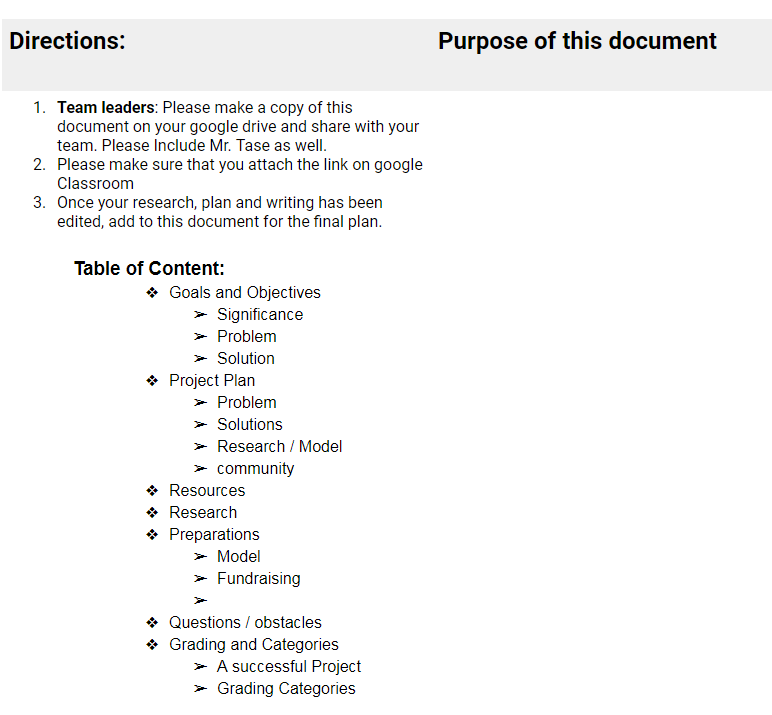
He gave students choice on what academic and agency skills they wanted to be assessed on.

And he gave them strengths-based evaluation options to enable choice in the calculation of final grades as well as a roadmap for what was being assessed.

Through all this process-based scaffolding, students learned to organize themselves. They applied content skills and learned the importance of precision and persistence.
Things often did not go smoothly. As Deina recounts with her experience with mounting the whiteboard she built, “I set everything up, and then realized that the measurements were off by ⅜ of an inch over a 21 foot wall span, and the frame that I built with the plastic did not fit. We had to take everything off again (and again) to try.”

But these mistakes led to learning and grew a desire to learn more. Students became deeply invested in the outcome of their work, and became innovative in trying to achieve what they wanted to achieve. They began exploring hacking processes. For example, the table group wanted the aesthetic of frosted plexiglass but it was beyond their budget. Instead of settling for another option, they experimented with creative workarounds. They sanded down clear plexiglass to make it seem frosted. They tried different grit sandpaper, both dry and in water. All term they were constantly juggling competing design criteria, from aesthetics to cost to complexity of fabrication.
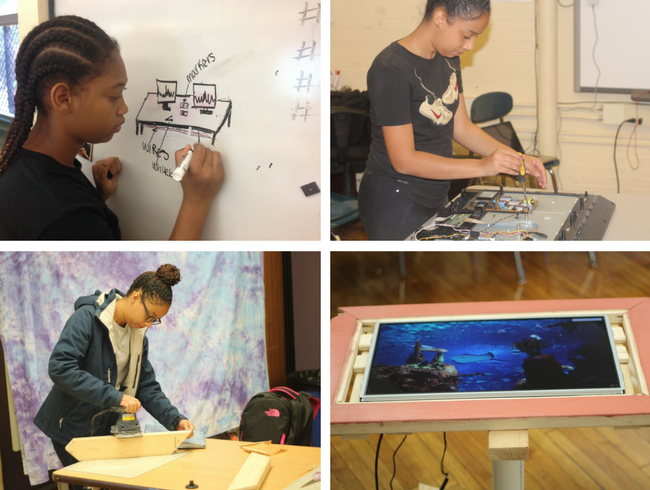
Through grappling with these criteria and variables, they learned how to make decisions: how to define, research, test, analyze, and execute on options.
The City of Boston and Boston Public Schools have recently launched a new College, Career, and Life Readiness Definition, the competencies all graduating students need in order to successfully navigate the innovation economy into which they will enter. This definition goes beyond content knowledge to add in wayfinding skills young people need to move successfully into a productive, satisfying, and sustaining adulthood. It has five components: set a vision, choose a course, change course, build competence, and work with others. Through their collaborative project in Panion’s class, our BINcA students have been living all of these components.
Down The Rabbit Hole: Deep Learning

What had begun as problem-finding led to a deep exploration of how learning could be made authentic. In Panion’s words, “I wanted this project to mimic real life, where problems aren’t created in a lab and have a formulaic solution; rather each set of solutions brings up new questions and the need for more solutions. I was not aware of how deep down the rabbit hole we would get.” The rabbit hole is where the deepest learning happened, the type of learning that impacts the learner’s core sense of self. This was equally true for the teacher and his students.
For Panion the rabbit hole redefined his understanding of what learning could be and grew his comfort with taking risks. He went through a series of doubts and uncertainties which he and his students overcame batch by batch. First off were operational issues:
I had some hopes of what the project would look like, but there were a lot of unknowns. Would the administration be ok with what we were doing? Would it turn into a simple research/present your findings, or something more exciting that would allow the students hands-on activities. Would it be too much and a source of frustration for the students to the point of giving up? Would finances be an issue? Could someone get hurt? When could we do the work? One hour of classroom time was not enough to allow us to complete these projects, and the building was closed on weekends. We had to clean up after each class, to prepare for the next class which took a lot of time.
Next were implementation/learning redesign issues. This way of teaching and learning was vastly different from anything Panion had been accustomed to:
Each step and day brought in new challenges and issues. The more the students explored their problems, the more creative, and complex the solutions would become. We used any and all types of materials and employees at Home Depot would give us the craziest looks: “You are trying to do what with the toilet flange?” or “What crazy project are you working on today?” We visited a wholesale plexiglass commercial shop to look at the variety of extruded plastics and plexiglass. The front yard of my house became a workshop, as I would take the measurements that the student would give me (wood/plastic) and cut them at home as to avoid injury. When things would break (and many did), we would try to use it as a lesson (we ruined 3 LED strips the first time that we put on the board, causing one of the students to be emotionally distraught—but it was awesome to see the students try to put a positive spin and try to fix things).
This new way of learning that blurred the boundaries between school and the outside world, between class and life, impacted the students as well. Carolyn explains what it felt like to her:
When Mr. Tase...told me that he was planning on a project of redesigning our classroom, the first thing that came to my mind was, this will be an easy project. We just have to design the way the classroom looks like, change its appearance but not its components. But this project proved me wrong. It was more complex than I thought it would be, it required more research, independency, and teamwork that I really didn't expect. The more deep I went into the project, the more unknowns, and learning occurred. Being faced with a challenge and not having the answers and solutions to it, in addition to figuring out extra time to work on my project was my rabbit hole. Time in class was never enough to produce anything because most of our work required cutting wood, plexiglass, and making things that were almost impossible to do in a classroom during a class period. Figuring out a time to come during the weekends was really difficult because as a group we needed to make decisions together and have a consensus, but we were always unable to meet all of us during the same day. At the end, we decided to be communicating every progress we did to each other through the phone. The more time we spent into this project the more tricky it got because it started requiring skills that I didn't have. Many times, I stopped to reflect on the progress that I have made; but then I started to think of all the challenges lying ahead and how I didn't have certain skills to solve it, like using a drill, jigsaw, sander, and radial arm saw. But I still persevered, the more I worked, the more I learned. And the more I practiced those skills the better I got at them. I went from just having an idea of how I wanted a table to look like to designing it, researching, comparing prices, creating fundraising letters, and actually building it.
Ideally, schools should be places that help young people discover and create senses of self, capable of making—and knowledgeable enough to make—an impact on the world. Authentic learning experiences like the one described above, where academic, technical, and social skills are embedded in the excitement and urgency of creating something real, foster the type of growth that leads to deep learning. They are emergent, problem-finding and problem-solving experiences rather than classrooms with predictable hierarchies, pathways, and outcomes, and for these reasons they are often boundary-blurring and messy. They are, however, well worth the risk and the effort––for our students and for our educators.


